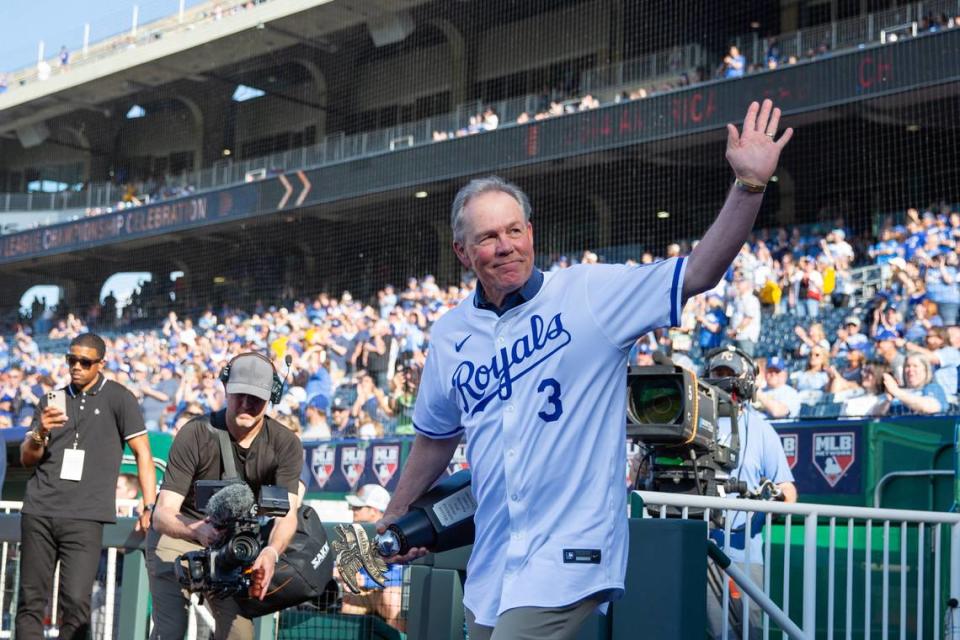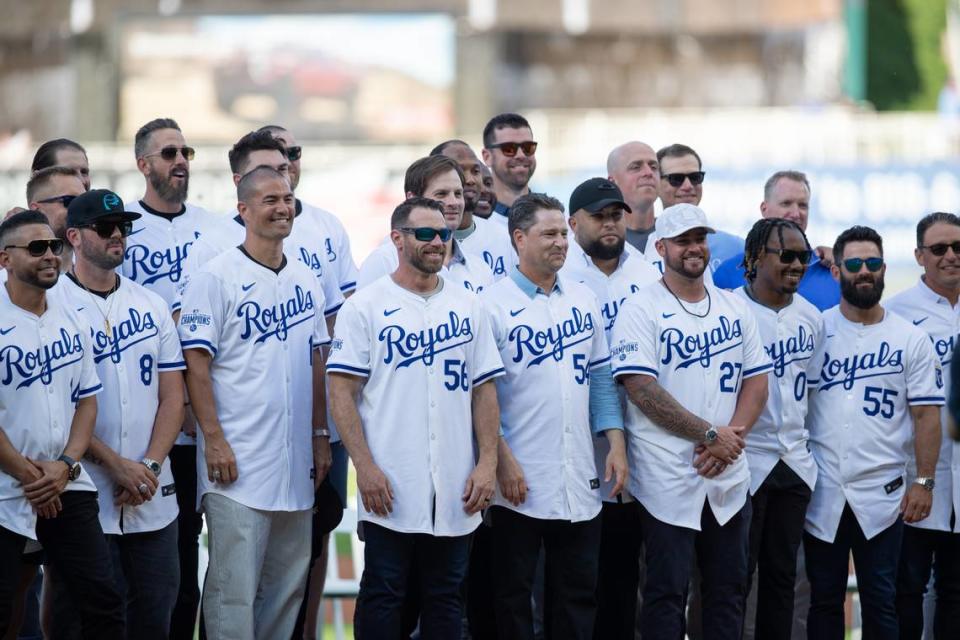How this year’s Royals are reminiscent of the 2014-15 teams — and whether it can last
The former Royals rolled into a downtown Kansas City hotel Thursday late afternoon, together serving as a reminder of a once-in-a-generation payoff.
It’s been 10 years since their celebration of the 2014 American League pennant, not to be confused with the 2015 World Series championship reunion that will come a year from now — though, let’s be honest, this weekend’s 10-year reunion is not their first actual reunion, anyway.
Several of these players arrived last May for former outfielder Lorenzo Cain’s emotional retirement ceremony on the Kauffman Stadium field. Or there was last September, when manager Ned Yost was inducted into the team’s Hall of Fame.
But all of those get-togethers — those representatives of the last Royals team to sniff a postseason — naturally prompted us to contrast the past with the present.
This year? It’s a refreshing change of pace. What follows is not a contrast, but instead a comparison. And there are actually some to be made.
You certainly recall that the defining quality of the 2014 team was the back end of its bullpen. Greg Holland, Wade Davis and Kelvin Herrera — every member of the proverbial HDH, an inscription on the mound Friday for the opening night of the celebration — posted an earned-run average of 1.41 or better.
That’s still the contrast.
But the comparison? It’s perhaps the second most notable characteristic of those 2014-15 teams. If not 1A, perhaps 1B.
The comebacks.
The most memorable game in that era, maybe any era, of Royals baseball came on Sept. 30, 2014, at Kauffman Stadium.
The Wild Card Game.
We don’t need to re-hash all 12 innings here — former Star beat writer Andy McCullough needed only a few thousand words to do that — but I do want to remember its effects.
Actually, they remember its effects.
“There was (no) situation that we couldn’t handle after that game,” former outfielder Alex Gordon said. “There were so many ups and downs — the season’s over; no, the season’s back. So every game after that was really easy. I think that’s why we went on the run that we did.”
“It just came to a point where if we executed that game plan or not, we were gonna win,” former first baseman Eric Hosmer said. “It didn’t really matter who we were playing. I think ultimately, as a group, when you get to that mindset, then there’s really good things that are going to happen.”
There’s a word for that, of course.
Confidence.
The Royals’ application came in the game’s pressure moments. The highest leverage. They were at their best late. They were just fine playing from behind.
Like, say, this year’s Royals have been.
Absent the experience — the foundation for its meaning — the Royals have tapped into that at-their-best-when-it-counts mantra. Their next step? Figuring out why it’s only in those moments.
There are some hard-to-believe numbers following this Royals team — so confounding, in fact, that the front office and coaching staff has spent considerable time trying to make sense of them.
The baseline first: The Royals have a .687 OPS (on-base plus slugging percentage) this season, which ranks about middle of the pack (17th) in baseball.
But the production changes drastically depending on the situation. They rank 7th in baseball in late-and-close situations, which means when they’re either leading by one run or trailing with the tying run in the on-deck circle.
They’ve had a terrible time against starting pitchers this season — well, to start a game. Look at these splits: They have the 29th-ranked OPS against starters the first time through the batting order, yet the very best OPS against starters the third time through the order.
Salvador Perez is the leader of that pack, 13 of 26, with the fourth-most total bases of any player in those opportunities.
I get it. Most lineups are better the third time they see a starter. But the comparison here isn’t first time through the order juxtaposed to the third time through. It’s against every other team in the league.
They go from one of baseball’s worst lineups at the start of the game to one of its very best deep into it.
The effect is in the result. The Royals have won five games when trailing after six innings, just one behind Detroit and Atlanta for the most in MLB. They’re 5-17 in that spot, a win percentage of .294.
The numbers will level out over the course of a full year, same as for the teams with a better win percentage through May 17, but to put that percentage in perspective: No team in baseball history has finished with better than a .191 winning percentage in that spot.
And it’s a mediocre lineup — without the vaunted HDH bullpen — doing it.
How?
The Royals have held meetings asking that very question.
“It’s something we’ve been talking about a lot, and we don’t have a clear answer on it ...” Picollo said. ”We’ll just keep trying different things, talking about different things. It’s not one answer for everybody. It’s an individual answer for each player. And once we figure it out, hopefully we’ll get a little more production.”
It’s, well, abnormal.
Is it sustainable?
Some of the advanced metrics put doubt into it. If the contrast is truly unexplainable, and they’re yet to explain it, typically something has to give. Of course, that something could be the front end of games, rather than the back end.
For the 2014-15 Royals, they never gave back anything. It became a feature. They don’t win the 2015 World Series without the AL Division Series comeback in Houston.
This year’s group enters the weekend series against the A’s seven games above .500.
A different bar, sure. But it’s a higher one than the past decade.
For at least one similar reason as the team from a decade ago.

 Yahoo Sports
Yahoo Sports 

